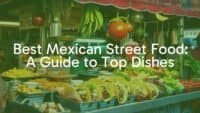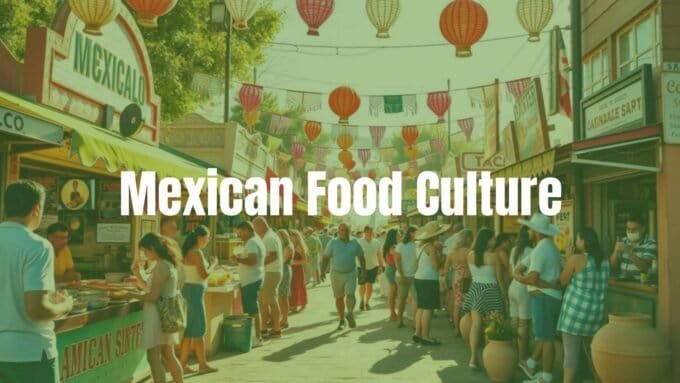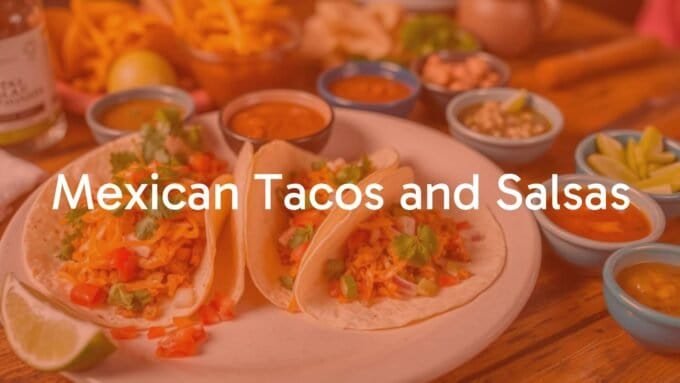What makes Mexican street food truly great? For many people, it’s the mix of fresh ingredients, rich traditions, and the lively street scene. Street food in Mexico goes beyond just filling your stomach-it’s a big part of the culture and a fun way to try different foods, from spicy tacos to cool fruit snacks. Eating on the street in Mexico is more than just a meal-it’s an experience that lets you taste the country’s history and daily life.
This guide will walk you through Mexico’s popular street food, highlighting classic dishes, the ingredients that make them special, and their importance in Mexican life. You’ll learn about favorite savory foods, sweet snacks, and popular drinks-everything that makes Mexican street food unique.

What Makes Mexican Street Food Stand Out?
Main Traits of Traditional Mexican Street Food
Traditional Mexican street food is full of flavors. It’s bold and colorful, and you often smell it before you see it. One of the key features is freshness-vendors often prepare your meal in front of you, using local and seasonal produce. Whether you’re having a fruit cup or freshly grilled meat, freshness matters the most.
Another big part is how Mexican street food mixes sweet, salty, spicy, and sour tastes together-even in a single bite. Imagine sweet fruit topped with chili powder, or chicken with rich mole sauce. Street food is also very diverse; nearly every dish found in a restaurant has a street version, giving you so many options to choose from.
Why Is Street Food Important in Mexican Life?
Street food is much more than quick eats-it’s a vital part of daily life in Mexico. It helps bring people together, whether at market stalls, roadside stands, or food carts in neighborhoods. These spots are hubs for friends and families to hang out, especially in the evenings.
Street food is also crucial because it’s affordable and accessible for everyone, showing the diversity of Mexico’s regions. Each place has its own special dishes. From Oaxaca’s moles to Tacos al Pastor, Mexican street food is also world-famous, even recognized by UNESCO as a key part of cultural heritage.
Main Ingredients in Mexican Street Food
Many Mexican street foods rely on a few staple ingredients. Corn, or maíz, is the most important-it’s used to make masa, which forms tortillas, tamales, sopes, and gorditas. Without corn, most street food wouldn’t exist.
Other common ingredients are chili peppers for heat, limes for tanginess, and plenty of fresh cilantro and onions for garnish. Oaxaca cheese is popular for its soft texture, and a range of meats like pork, beef, and chicken are used for filling. Vendors season these meats with spices, making street food full of taste.

Popular Types of Mexican Street Food
Savory Mexican Street Eats
The savory choices are often the stars of street food. Most are made with a base of corn, topped or filled with meats, veggies, and cheese. Tacos are the most famous, but you’ll also find tortas, tamales, quesadillas, sopes, and gorditas. Each region has its own way of preparing these, so the variety is huge-from Oaxaca’s crispy tlayudas to slow-cooked barbacoa.
What they have in common is careful cooking-slow roasting, grilling, and skillful use of herbs and spices result in street food that’s flavorful and satisfying.
Sweets and Snack Foods
Besides savory meals, Mexican street food also offers tasty snacks and sweets. Fruit cups are common, and so are sweets that mix sweet, spicy, and sour flavors. You’ll see churros (fried dough with cinnamon sugar), paletas (fruit popsicles), and unique snacks like duritos (crunchy wheat snacks) and Dorilocos (chips with toppings). All these treats can be bought from colorful carts on city streets.
Refreshing Mexican Street Drinks
To go along with all the spicy and rich food, street vendors sell drinks made from fruit and other natural ingredients. Agua frescas are popular drinks made by blending fruit (like hibiscus, tamarind, or rice), water, and sugar. For something different, drinks like tejate from Oaxaca (made with cocoa and corn) or tepache (lightly fermented pineapple drink) are worth trying. Mangonadas, with mango, chamoy, and chili, are sweet, tangy, and spicy all at once.
Top Mexican Street Foods (Savory)
Tacos: The Most Popular Street Food
Tacos are a classic Mexican street food. They usually use a soft, fresh corn tortilla topped with a meat filling, onions, cilantro, and salsa. They’re simple but packed with flavor.
Tacos vary by region. Mexico City is known for Al Pastor (pork cooked on a spit with pineapple); north Mexico has Carne Asada (grilled steak); while Carnitas (slow-cooked pork) are a favorite elsewhere. You’ll also find Guisados (stews), and adventurous versions like Cabeza (beef head) or Tripitas (intestines). Every place and vendor has their own style.

Tortas: Mexican-Style Sandwiches
Tortas are big, filling Mexican sandwiches made on soft bread, then grilled for extra crunch. The fillings are often similar to those in tacos (like Carnitas or Al Pastor), with extras such as beans, avocado, and salsa. Some, like the Cubana, pile on meats, cheese, and vegetables for a huge meal. Tortas show off the creative side of Mexican street food.
Tamales: Steamed Corn Dough with Fillings
Tamales are made with corn masa and stuffed with a filling before being wrapped in a corn husk or banana leaf and steamed. Fillings can be savory-like chicken or pork in salsa-or sweet, with fruit flavors. Tamales are found everywhere on the street, often sold from bikes or carts.
Elotes and Esquites: Corn Snacks
Elotes are cobs of corn grilled or boiled, spread with mayo, cheese, chili powder, and lime. They’re messy but delicious. Esquites are similar, but the corn is cut off the cob, mixed with the same toppings, and served in a cup. Both make the most of Mexico’s love for corn by turning simple ingredients into something really tasty.
Quesadillas and Sopes
Quesadillas use a tortilla filled with cheese (and sometimes meat or veggies) and are griddled until melty. Fillings could be cheese, squash blossoms, or huitlacoche (a flavorful corn fungus). Sopes are thicker corn bases pinched at the edges and topped with beans, cheese, and salsa. They’re hearty, with a chewy center and lots of toppings. In Oaxaca, these are called Memelas, which have gained worldwide attention.
Gorditas and Tlacoyos
Gorditas are thick, stuffed corn cakes, usually filled with meat, cheese, or beans, and then fried. They have a crispy outside and soft inside. Tlacoyos are oval-shaped and filled inside with beans, cheese, or potato before being cooked. Both use simple ingredients to create comfort food snacks.
Birria and Barbacoa
Both Birria and Barbacoa are meats cooked slowly to make them very tender. Birria, from Jalisco, is usually goat or beef in a spicy, flavored broth and is often served in tacos dipped in the cooking juices for extra flavor. Barbacoa uses beef or lamb, cooked slowly until soft, and usually served in tacos with fresh toppings. These dishes offer some of the deepest, richest flavors from Mexican street stalls.
Tlayudas and Other Local Dishes
Some street foods are regional. Tlayudas from Oaxaca are sometimes called “Mexican pizza”-large, crisp tortillas with beans, cheese, cabbage, and meat, often folded in half. Molotes from Puebla are deep-fried corn dough with chorizo and cheese. Chalupas, fried dough with savory toppings, and the stews Pozole and Menudo, made with hominy and meat, also have street food versions. Exploring local specialties lets you discover Mexico’s diverse food scenes.
Famous Mexican Sweets and Snacks
Churros and Buñuelos
Churros are long, fried pastries coated in cinnamon sugar, with a crunchy outside and soft inside-sometimes served with chocolate, caramel, or condensed milk. Buñuelos are thin, crispy disks, fried and sweetened with syrup or sugar. Both are popular, especially on weekends and holidays.
Fruit Cups and Raspados
Street fruit carts offer cups of fresh, cut fruit like mango, watermelon, pineapple, and papaya, usually topped with lime, salt, and chili powder for more flavor. Raspados, or shaved ice cups, are topped with fruit syrups, for a cold treat on hot days.
Chicharrón, Duritos, and Crunchy Snacks
Chicharrón is fried pork skin-either in big, airy pieces or bite-sized bits-topped with chili sauce and lime. Duritos are crisp, wheel-shaped wheat snacks topped with salsa and lime. Vendors also sell fresh potato chips with the same toppings. These snacks are perfect when you’re looking for something salty and crispy.

Mangonada and Paletas
Mangonada is a cold mango treat made with mango puree, chamoy (a tangy sauce), more mango chunks, chili powder, and often served with a tamarind candy straw. Paletas are Mexican popsicles-either fruit-based or creamy-with lots of fresh fruit. Mango chili is a popular mix, combining sweet and spicy flavors.
Mexican Candy and Tamarind Sweets
Mexican candies are very different from those in the US or Europe. Most are sweet, sour, and spicy all at once, often using tamarind. Brands like Pulparindo and Pelón Pelo Rico are popular. You’ll also find candy shaped like noodles (“Salsaghetti”) or covered in chili-like Vero Mango, a mango lollipop rolled in chili powder.
Mazapanes and Traditional Sweets
Mazapanes are crumbly peanut candies, sweet and nutty and famous for their delicate texture. Coconut bars and chili-covered fruit lollipops are also popular for their unique flavors. These sweets give you a taste of Mexican tradition and creativity.
Dorilocos and Snack Mixes
Dorilocos start with a bag of Doritos cut open and loaded with toppings like cucumber, carrots, peanuts, corn, and hot sauce. Eaten with a fork, they’re crunchy, spicy, and tangy, all at once. Snack carts often sell chili-flavored plantain chips, nuts, and seeds for even more options.
Common Mexican Street Drinks
Agua Fresca and Horchata
If you need something to drink, agua frescas are everywhere-light drinks made by blending water with fruit, flower, or seed, and sugar. Jamaica (hibiscus), tamarind, and guava are favorites. Horchata is a sweet rice milk drink with cinnamon flavor, smooth and cooling, great with spicy food.
Tejate and Other Classic Drinks
Tejate, popular in Oaxaca, combines cocoa and corn for a rich, slightly earthy taste. Tepache is a sweet, slightly fermented drink made from pineapple peels, cinnamon, and brown sugar, with a little alcohol from the fermentation-sort of like natural soda.
Hot Chocolate and Atole
Mexican hot chocolate is made with water, not milk, and has a stronger chocolate flavor, often with cinnamon or even chili. Atole-thickened with masa (corn dough)-comes in plain, chocolate (called champurrado), or fruit versions. Both are warming and often enjoyed with tamales for breakfast or on cool evenings.
Where to Try Top Mexican Street Food
Popular Markets and Street Stalls
The best street food is often found in busy markets and at simple carts on city corners. Mexico City is famous for this, with giant markets like Mercado La Merced offering everything from produce to snacks. For the best street food, follow the locals to the busiest stands-these spots usually serve the freshest and tastiest items. Vendors who specialize in one or two dishes often make them exceptionally well.
Regional Favorites and Food Destinations
Each region of Mexico is known for different street foods. In Oaxaca, try tlayudas and mole tamales; Puebla is known for molotes and chile en nogada; Guadalajara for tequila and local specialties. Even neighborhoods can be known for their food, like Roma Norte in Mexico City, or famous taco stands like El Vilsito. Each place adds its own flavors and traditions.
How to Eat and Order Street Food Like a Local
Tips for Eating Street Food
Buying street food for the first time may seem intimidating, but it’s easy once you know how. Look for stands with photos or menus and lots of customers. Tacos are small, so order a few at once. If you’re not sure what to get, point to what others are eating or ask the vendor for a suggestion.
Usually, you pay after eating. Tipping isn’t required, but appreciated if you feel like it. Cash is best because most vendors don’t take cards. Most stalls also have seating so you can enjoy your meal there.
Staying Safe and Healthy
If you’re worried about stomach issues, watch for stands that are busy and look clean-high customer turnover means fresh food. See how vendors prepare and serve food, especially meat, to be sure it’s cooked through. Wash your hands or use sanitizer before eating, as a lot of issues come from dirty hands, not the food itself. If you’re sensitive to spicy sauces, try a small amount first. By being a little careful, you can enjoy street food safely and happily.
Frequently Asked Questions about Mexican Street Food
What Are Antojitos?
“Antojitos” means “little cravings” and refers to popular Mexican street snacks usually made from corn-like tacos, quesadillas, sopes, gorditas, tamales, and tlacoyos. They’re meant to be eaten on the go and are sold by vendors in stalls or carts. Their name shows how irresistible and important they are in daily life.
Are There Vegetarian Mexican Street Food Options?
Yes, there are lots of vegetarian choices. Many corn-based antojitos-like quesadillas (with cheese, squash blossom, or huitlacoche), sopes, gorditas (with beans or cheese), and tamales filled with cheese or sweet fillings-are meat-free. Elotes and esquites (corn with mayo, cheese, chili, and lime) are also vegetarian. Fruit cups with lime and chili, and tlacoyos with beans, cheese, or potato are other good vegetarian options. Even some regional dishes, like enfrijoladas (tortillas with black bean sauce), are vegetarian. There’s plenty for vegetarians to try in Mexican street food.
What’s the Most Popular Mexican Street Food?
The taco is the most-loved and well-known Mexican street food. Its range of fillings and simple, tasty preparation have made it a staple across the country and around the world. From Al Pastor (spit-grilled pork with pineapple) to Carnitas and Carne Asada, the taco is enjoyed at all times of the day, by locals and tourists alike. It’s a true symbol of Mexican street food culture.














Leave a comment